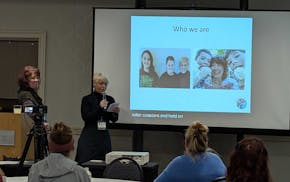If you are like many people, you love to have written more than you love to write. The hard part is getting there.
Writing involves many steps — gathering information, clarifying your purpose, analyzing your reader's interests and needs, formulating a persuasive strategy, organizing your material, finding the right words, editing for wordiness and clarity and proofreading for errors in word choice, spelling, grammar and punctuation. All are important in the process of completing longer documents.
It's hard work, but if you take it step by step, it's not so bad. Here's how:
1. Begin not with writing — not with words, grammar and punctuation — but with questions. Ask yourself what you are trying to accomplish. What do you want your reader to do or think as a result of reading your document? You are not ready to write until you can complete this sentence: The purpose of this document is to ...
2. Think about your reader. Get outside your own head and your preoccupation with the information you want to convey, and ask yourself what the reader cares about. How can you recognize or appeal to your reader's interests and values? How can you address your reader's concerns? How much does the reader know, or care, about your subject? How much do you need to explain? How much detail is enough? How much is too much?
3. Formulate a persuasive strategy. If your reader is sympathetic to your message, you might want to take a direct (solution/explanation) approach, opening with your recommendation and following with your reasons. If your reader is indifferent or hostile to your message, you might want to take an indirect (explanation/solution) approach, opening with an explanation of the problem and following with a suggestion for solving it.
4. With your persuasive strategy in mind, organize your information, based perhaps on importance, chronology or increasing complexity, beginning with more basic concepts and progressing to more complex. The longer and more complicated your information, the more detailed your outline should be.
5. Draft your opening and closing paragraphs, knowing you might revise these as the process of writing clarifies your thinking.
6. Now connect the dots. Draft the body of your document, using your outline as your guide. The main headings of your outline might serve as topic sentences for your paragraphs or as headings for your document. Take care with your tone. Choose words that are appropriate for your relationship with your reader. Try to limit your editing and revising for now. Save that step for later.
7. If possible, set your draft aside and then take another look.
8. Finally, be sure to proofread for errors — embarrassing, annoying and maddening errors such as proof read for proofread and lose for loose.
Stephen Wilbers offers training seminars in effective business writing. E-mail him at wilbe004@umn.edu. His website is www.wilbers.com.

U.S. Bancorp executive stopped responding to control tower minutes before Brooklyn Park crash

Minneapolis condo in historic Midtown Exchange building listed for $205,000

RFK Jr.'s controversial comments draw ire at Minnesota autism convention

Big medical expenses drove $176 million operating loss last year at Medica

